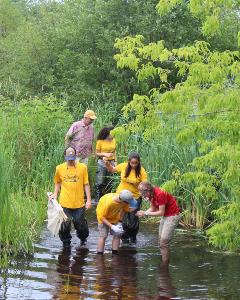New York >> “Whoa!! What was that??” exclaimed an enthusiastic student. Turned out it was an otter, up close, in an opening in the streambank’s cattails. She was curious about what all the activity was on “her” stream. Of course, everyone was slow to react, so no pictures were taken before the otter slid out of sight, but I’d be willing to bet that all present will have that scene etched in their memories forever.
The otter appeared during the wrap up of a busy day of hands-on interactive activities for the participants, on waterways and waterbodies in the Indian River Lakes watershed. The program, Protectors of Water and Habitat on the Indian River Lakes (WHIRL) was created when several Central New York (CNY) Chapter Ikes visited with staff and board members from the Indian River Lakes Conservancy (IRLC). IRLC is an influential and growing land trust dedicated to educating the public about the region’s unique beauty, its opportunities and protecting it all.
The CNY Chapter had been looking for ways to get young people involved in outdoor projects. Alarmed at the scarcity of youth becoming involved in service organizations these days, the chapter concluded that active engagement in interesting projects is vital and, if organizations like the Izaak Walton League are to survive and thrive, we need to catch the interest of youth who are constantly exposed to multiple media distractions and lead ever-busier lives.
The IRLC was very enthusiastic about a collaborative effort and soon our chapter was joined by other like-minded organizations with good ideas on how to engage area high school students in a regional natural resource education program.
The natural landscape in and around the Indian River Lakes drains into the St. Lawrence River on the U.S./Canada border. Scoured to bedrock by the last ice age, this is a unique and beautiful lake-studded region; a hard region, both geographically and economically. The area is sparsely populated, with an ever-growing influx of lake camp owners that boost the summer population.
 WHIRL stewards beginning their macroinvertebrate investigation on Jewett Creek, a tributary to the Indian River.
WHIRL stewards beginning their macroinvertebrate investigation on Jewett Creek, a tributary to the Indian River.
2019, our first year of WHIRL, proved a great success! Our programs in Aquatic Resource Education and Invasive Species brought together people of different ages and experience who are interested in the environment and want to learn from one another and grow a community focused on protecting water quality. In addition, we encouraged the kids to think about college and future employment in environmental fields.
This six-week summer program had students monitoring water quality, assessing ecological communities, implementing lake management plans and conducting invasive species surveys. Activities also included creating field reports to guide invasive prevention and a college visit/tour with a limnology (study of freshwater systems) professor. A “Media Day” gave students an opportunity to demonstrate what they were doing and what they had learned to the media, lake association representatives and the interested public. Some students took it upon themselves to pass on what they learned, presenting to community organizations (4-H, Boy Scouts). What a testament to a successful program!
2020 began with great enthusiasm for bigger and better, but then the pandemic hit. Not to be deterred, organizers met weekly to fashion a quality virtual program. Though disappointed by social distancing rules, we were again able to provide a fantastic experience to the participants, even adding a component on watershed management and tripling our attendance numbers! Curriculum was developed that provided the students with online educational instruction and learning materials, gave direction on tasks for them to complete and followed up with reports on their findings.
We expect that in the future online learning will complement in-field educational experiences. To catch and keep the interest of the participating mentors and mentees during online presentations, we plan to solicit help from area college students whose concentrations include videography and documentary development. In working with our natural resource experts, these students, under the eye of their professors, will bring forth high-quality presentations that will “pop” and greatly assist us in trainings and field activities.
Once completed, our catalog of video tutorials will be available for future mentors and participants to use, easing a worry that sometimes scares off potential mentors who may not yet be confident in their ability to bring a high-quality experience to engaged kids. Also, these tutorials can be used by our young people who may be interested in working with other youth groups in the community. These initiatives will bring added value to our outdoor hands-on activities, which remain the heart and soul of nature education. We can’t wait for next summer!
Partners in the WHIRL program are: Indian Lakes Conservancy, NY State Parks and Recreation (FORCES program), Invasive Species Management (St. Lawrence, Eastern Lake Ontario) and Paul Smith’s College.